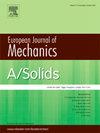基于非局部gurson公式的延性裂纹扩展建模与三维模拟
IF 4.2
2区 工程技术
Q1 MECHANICS
引用次数: 0
摘要
如今,延性断裂微观力学的成熟状态使得在非局部公式中使用复杂的基于物理的孔洞成核、扩展和合并机制描述,在3D中模拟广泛的裂纹扩展成为可能。在这里,与韧性裂纹扩展有关的不同现象在断裂力学试样的背景下被处理。许多关键部件的结构完整性评估确实依赖于预先存在的尖锐缺陷的裂纹扩展的预测模型。采用两个相似的扩展Gurson模型,通过对比交叉验证其数值实现,得到了板厚、塑性各向异性和应变硬化影响的结果。由于模拟的三维性质捕捉到了裂纹尖端颈缩现象,因此可以捕捉到断裂韧性随厚度先增加后减少直至平面应变的变化。非局部公式引入了一个长度尺度,该尺度设置了断裂韧性取决于厚度的范围。令人惊讶的是,当使用同质几何时,厚度效应消失了。塑性各向异性的影响是特别重要的,当裂纹生长在具有显著的裂纹尖端颈缩的薄板上时,通过影响颈部的塑性耗散。大的应变硬化能力大大提高了断裂韧性,当裂纹尖端发生颈缩时,这种效果在3D中被放大。这些发现只是对延性撕裂这一重要领域中许多遗留问题的一组有限的答案,为未来几年固体力学界制定了雄心勃勃的路线图。这些问题在现代技术的背景下尤为重要,例如H2存储、增材制造、新型高强度金属合金的开发以及第四代核裂变和聚变反应堆等等。本文章由计算机程序翻译,如有差异,请以英文原文为准。
Modeling and 3D simulation of ductile crack growth with non-local Gurson-based formulation
The state of maturity of the micromechanics of ductile fracture is such that it is possible, today, to simulate extensive crack growth in 3D using a sophisticated physics-based description of the mechanisms of nucleation, growth and coalescence of voids within a non-local formulation. Here, different phenomena related to ductile crack growth are addressed in the context of fracture mechanics specimens. Structural integrity assessment of many critical components does indeed rely on predictive models of crack growth from pre-existing sharp defects. Two similar extended Gurson models are used, after comparison to cross-verify their numerical implementation, to generate results about the effect of plate thickness, plastic anisotropy and strain hardening. The variation of the fracture toughness increasing and then decreasing with thickness down to the plane strain regime is captured owing to the 3D nature of the simulations that captures the crack tip necking phenomenon. The non-local formulation introduces a length scale that sets the range over which the fracture toughness depends on thickness. Surprizingly, the thickness effect disappears when using homothetic geometries. The effect of plasticity anisotropy is shown to be particularly important when a crack grows in sheets exhibiting significant crack tip necking by impacting among other the plastic dissipation in the neck. A large strain hardening capacity enhances very much the fracture toughness, an effect that is amplified in 3D when crack tip necking takes place. These findings constitute only a limited set of answers to many remaining questions in the important field of ductile tearing, setting an ambitious roadmap for the years to come to the solid mechanics community. These questions are particularly important in the context of modern technologies such as storage, additive manufacturing, new high strength metallic alloys development, and generation IV nuclear fission and fusion reactors to name a few.
求助全文
通过发布文献求助,成功后即可免费获取论文全文。
去求助
来源期刊
CiteScore
7.00
自引率
7.30%
发文量
275
审稿时长
48 days
期刊介绍:
The European Journal of Mechanics endash; A/Solids continues to publish articles in English in all areas of Solid Mechanics from the physical and mathematical basis to materials engineering, technological applications and methods of modern computational mechanics, both pure and applied research.

 求助内容:
求助内容: 应助结果提醒方式:
应助结果提醒方式:


